22 September
Conferences
THE BAROQUE IN LARRAGA
The main altarpiece of Larraga in its Navarrese and Hispanic context
D. Ricardo Fernández Gracia
Director of the Chairof Navarrese Heritage and Art
The retablo (from the Latin retro-tabulum: table behind) has its origins in the liturgical custom of placing relics on altars. When these became scarce or simply ran out, it was necessary to be content with placing images in the form of diptychs and triptychs. Subsequently, when the altar's altar was filled with sacred vessels, candelabra and other objects for the celebration of mass, the figure of the saint, Christ or the Virgin was painted on a panel that was placed in front of the altar (frontal or antependium) until the priest officiated towards the east, with his back to the faithful. Then, as the frontal was no longer visible, the iconic representation was placed behind and above the altar in order to make it fully visible. This is how altarpieces arose and developed, especially in the leaveAge average.
By the end of the Middle Ages, the altarpiece had evolved into a gigantic machine that housed complete painted cycles of the life of Christ, the Virgin and the saints, even occupying the entire chevet of a church. At that time the genre of the altarpiece was generally in the hands of the painters who were in charge of their scarce masonries or sublet them.
This custom continued during the 16th century, although sculptural altarpieces competed with pictorial ones, gaining ground in many regions and, therefore, painters ceased to be the main protagonists in the contracting of altarpieces. However, it was undoubtedly in the Baroque period, that is, during the 17th and 18th centuries, when the altarpiece reached its greatest splendour and Degree development .
The vibration of their forms, the density of their decoration and the multiplicity of their images gave the Hispanic temples, almost always with rigid, inert walls cut at right angles, a sensation of mobilityand expansion of space that they lacked structurally. The altarpieces thus created an illusionism that was very characteristic of the Baroque.
The primary purpose of an altarpiece was to decorate and contribute to the perfection, splendour and beauty of the temple and chapel that housed it, as it was the object that best fulfilled this purpose inside the temple. Its mission statementwas to serve to worship God, as well as to try to put the faithful in contactwith the heavenly world through the veneration of the sacred images. Tapié states that "the altarpieces responded to a religion of ostentation which wanted to give its rites the greatest possible solemnity and brilliance, and which was pleased to erect a triumphal arch above each altar".
Rodríguez G. de Ceballos states that the main altarpiece of the church served wonderfully for the function of learning, contemplating its iconographies, while listening to the sermon, since the preacher could almost point his finger from the pulpit at the scenes in painting or relief to support his words, "in the manner of the blind coplero pointing with a wand in the street at the drawings displayed before the spectators who listened spellbound to his story".
The altarpiece, therefore, was not just another object in the temple to instil greater veneration, but had its projection and life inside the sacred space. In Sánchez Mesa's opinion, no other element took on the overflowing character of the altarpiece, since the Baroque, intended to exalt the senses and move behaviour, found in this artistic genre an excellent means for its purposes, with its forms, ornamentation, artifice, light, fantasy, richness, colour and, of course, the sacred images. The altarpiece, wrapped in the rich liturgical ceremonial and polyphony, became a spectacle for all the senses, provoking the senses, moving and unnerving the individual, always with the aim of moving and convincing through the senses, which were much more vulnerable than the intellect.
For everything related to the genre of the altarpiece and its evolution in the different stages in Navarre, we refer to our doctoral thesis , published in 2003.
The authors: Fermín de Larrainzar and Francisco Jiménez Bazcardo
The material author was Fermín de Larrainzar (c.1674-1741), who was the son of a carpenter and was related to other masters, such as the Aragonese sculptor Manuel Gil and the multifaceted José Pérez de Eulate, who married one of his daughters. His training, which began in the family workshop, was completed in 1691 in one of the best workshops in Pamplona in the last third of the 17th century, under the direction of Juan Barón de Guerendiain. In 1695 he took his entrance examination to the guild-guild of San José, specialising in carpentry, assembly and architecture. degree programHis artistic career was rapid and, in addition to being appointed overseer of works for the diocese of Pamplona, he was responsible for most of the altarpieces of the best clients of the bishopric, such as those of the cathedral ambulatory and the Bernardas de Lazcano. In 1700, he brought a lawsuit against the aforementioned guild to differentiate architecture - considering it to be a liberal art - from assemblage, in order to emancipate himself from the concept of craftsmanship and acquire a certain intellectual recognition. Among his most outstanding works are the Larraga major altarpiece (1696), the Ujué collaterals (1702), the Santa Catalina de Cirauqui major altarpiece (1703), the missing collaterals of San Saturnino de Pamplona (1706), the execution of the lost plasterwork programme of the chapel of San Fermín in Pamplona (1708), the altarpieces of the ambulatory of the cathedral (1713), the three altarpieces of the nuns of Lazcano (1717) and the main altarpiece and collaterals of San Nicolás in Pamplona (1708 and 1720).
With regard to the sculptor, Francisco Jiménez Bazcardo, it should be noted that he is one of the few masters working in sculpture in Navarre. He was the son of Diego Jiménez II or "the young" (†1660), from a dynasty of sculptors, and Micaela Bazcardo, married in 1641. Micaela was the daughter of the master Juan de Bazcardo (†1653). Among other works, she made the sculpture of the collaterals of Pamplona Cathedral and of the main one in Lerga, the latter works being commissioned by Simón Iroz y Villava in 1682. In the case of the cathedral collaterals, in 1682 the cathedral chapter ordered the authors of the altarpiece: "that for the sculpture they should make use of the said Francisco Jiménez, with the proviso that if they did not make them to the satisfaction of the said chapter or did not agree with it, the grantors should make another who was an expert to make and manufacture the sculpture with the necessary perfection".
In Larraga, he received the commission from Larrainzar in 1697, who had undertaken to make the bultos "of patron saintSan Miguel, those of San Pedro, San Pablo, San Fermín, San Francisco Xavier in the places already mentioned and at the top a saint Christ and on the sides Our Lady and San Juan Evangelista, being as they must all be made and worked according to good art and disposition and they must be of a length that denotes the design and plan".
datahistorical
Larráinzar's first major work was the Larraga altarpiece, contracted in 1696. The previous altarpiece must have been quite battered by the passage of time and two years earlier, in 1694, an attempt was made to restore and secure it, for which the opinion of Juan Francisco Ortiz, Miranda's master architect, was requested, who declared on 22 December of that year that it was not advisable to retouch the piece as the frame was worn and, in general, all the wood was very worn. The next step was to call in some master craftsmen in 1696 to understand the design of the new altarpiece that was already being planned. For this purpose, Rafael Díaz de Jáuregui and Simón de Iroz came to Larraga from Villava and Fermín de Ansorena from Estella. The first two drew up a layout and drew up an extensive set of conditions, which was ready by 5 August of that year, while the master from Estella also drew up another design. At the end of August, a candle auction was held to award the altarpiece. Posters announcing the auction had previously been posted at the heads of the merindad and elsewhere. The auction was attended by several masters who bid, among them Larráinzar, who was awarded the work for 650 ducats against other craftsmen who also placed bids, among whom the documentation mentions Juan Almándoz, Martín de Legarra, Domingo Sánchez and another who is named as "the master of Lerín" . The parish account book states that officials from both Navarre and Castile came and that they were all served refreshments at the end of the auction.
At the same time, or a little earlier, the two designs presented by Vicente López Frías and José Echeverría, masters appointed by their authors, the parish and Larráinzar, who, as the successful bidder, had to pay for one of them, were valued at the same time or a little earlier. Rafael Díaz de Jáuregui felt aggrieved by the price given to his work and that of his colleague Simón de Iroz and communicated that he did not consent to this, perhaps because he was not awarded the altarpiece as they had possibly expected.
With the capitals drawn up by the Villava masters and some small contributions, Fermín de Larráinzar undertook to make the main altarpiece in coral pine wood, with the perfect assembly based on good hidden tenons, using the old tabernacle and with the express condition that all the columns of the altarpiece had to be Solomonic dressed in carving. The deadlineof submissionwas set for the day of San Miguel in 1698 and the payments would be made in 200 ducats at signatureof the deed, another 200 the following year and other instalments in wheat or cash until fill inthe agreed amount. The payment of the 300 reales for the design by the masters of Villava was to be paid by Larráinzar himself, who was to make up for it from the total payment for the altarpiece.
patron saintAmong the conditions signed by the master from Pamplona was one in which he undertook to make the sculptures of the altarpiece, "which are those of Saint Michael, Saint Peter, Saint Paul, Saint Fermin, Saint Francis Xavier in the places already mentioned and at the top a Saint Christ and at the sides Our Lady and Saint John the Evangelist, all of them being made and travaxed according to good art and disposition and they must be the length that denotes the design and plan". However, this master architect, like most of them, was not a sculptor and he found it necessary to hire one of whom we have preserved testimony because Larráinzar himself drew up a notarial document on 7 October 1697, the sculptor Juan Bazcardo, a resident of Viana, transferring this part of his obligation to him. For all the aforementioned sculptures, he undertook to pay Bazcardo the sum of 124 ducats, of which he advanced 50 in the same act of notarisation before the notary.
Once the altarpiece was finished, he officially handed it over to the parish's board of trusteesand the members of this institution considered that the packages of San Francisco Javier and San Fermín would be better with their niches, so the aforementioned Structureswere commissioned in September 1699 from Larráinzar himself. The account book indicates that the master was paid 890 reales for this work, in addition to the sums owed to him under the contract signed in 1696.
A fact that should not be overlooked and which appears in the contract is the care taken by those in charge of the parish church, board of trustees, not to hide something of which they were very proud, the large apse-shaped veneration and its trumpets, also in the shape of a shell, works from the 16th century. This is expressed in one of the clauses of the aforementioned agreement: " It is a condition that the aforementioned altarpiece must close and fill the entire width of the aforementioned chapel as wide as samplethe aforementioned design up to two shells of crushed stone that the aforementioned chapel has, and that it must be enjoyed, taking the work out by the second movements of the plan of the top as samplethe aforementioned design". A fine example of the coexistence of styles and works.
The altarpiece
The Larraga altarpiece belongs to the decorative and traditional Baroque period. It has been preserved with some modifications, such as the regrettable loss of the tabernacle-exhibitor, the substitution of some images and the addition of canvases in poor taste on the bench. A first glance reveals how the original plan of 1696 was modified in 1699 when the foliage flutings on both sides of the attic were replaced, as befits the modelaltarpiece, with niches of the patron saints of the kingdom of Navarre.
The general outlineis somewhat retarded, especially its layout and, as far as its decoration is concerned, it lacks the richness and boldness of the vegetal carving that appears in the altarpieces of the great masters of the Ribera or Tierra Estella of the time. It is undoubtedly a work emanating from the tradition of the masters of Pamplona and Villava, who maintained archaic schemes both in the general approach and in some architectural elements. It consists of a small bench, excessively small for the proportions of the altarpiece, a tripartite body articulated by Solomonic columns with large garlands of palm leaves and a top on a developed bench, the latter structure disappearing in the central street to make room for the small niche of the titular San Miguel. This attic is articulated by means of triple T-shaped buttresses, on different levels with rich fruit pinjantes and at its sides the niches of the 1696 reform with small flutings at the ends. The decoration of the columns reminds us of contemporary works such as the façade of the basilica of San Gregorio Ostiense designed by Vicente de Frías in 1696 or altarpieces such as the altarpiece of Santa Catalina in Pamplona cathedral, the work of Miguel de Bengoechea and José Munárriz (1686).
As for the rest, the Larraga altarpiece is a faithful exponent of how the decorative and traditional style had reached Pamplona by this point in the century, although, as has already been indicated, the decoration is more that of a craftsman's workshop than that of an authentic artist.
Its iconography contains the patron saints of the universal church - Saint Peter and Saint Paul - on both sides of the tabernacle, gilded in 1700 by Pedro Francisco de Landa and polychromed again in 1748, and the patron saints of the kingdom: Saint Fermin and Saint Francis Xavier. The latter sculpture dates from the beginning of the 20th century. On the main axis, the figure of Saint Michael is not the one contracted in 1697, but an earlier one that belongs to the second third of the 16th century. The images of the Calvary are the work of the aforementioned Francisco Jiménez Bazcardo.

Interior of the parish church of Larraga, 16th-17th centuries. Photo I. Yoldi

Larraga main altarpiece, by Fermín de Larrainzar, 1696-99. Photo I. Yoldi
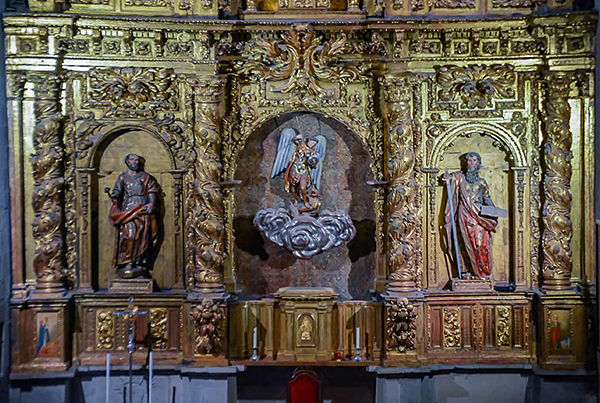
First section of the main altarpiece in Larraga, by Fermín de Larrainzar, 1696-99. Photo I. Yoldi
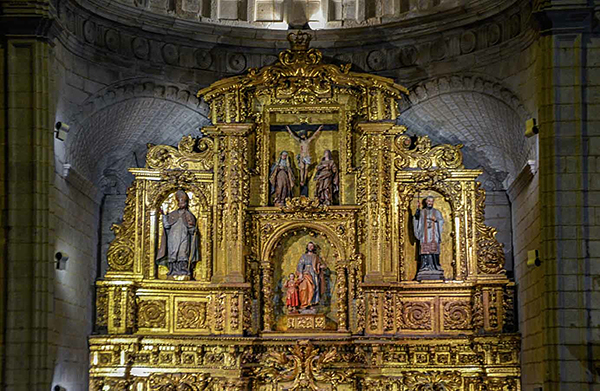
Second section and top of the main altarpiece of Larraga, by Fermín de Larrainzar, 1696-99. Photo I. Yoldi
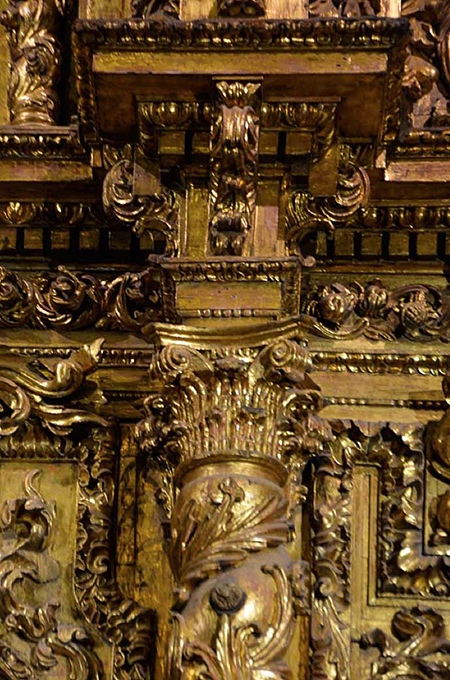
Column and entablature of the main altarpiece of Larraga, by Fermín de Larrainzar, 1696-99. Photo I. Yoldi
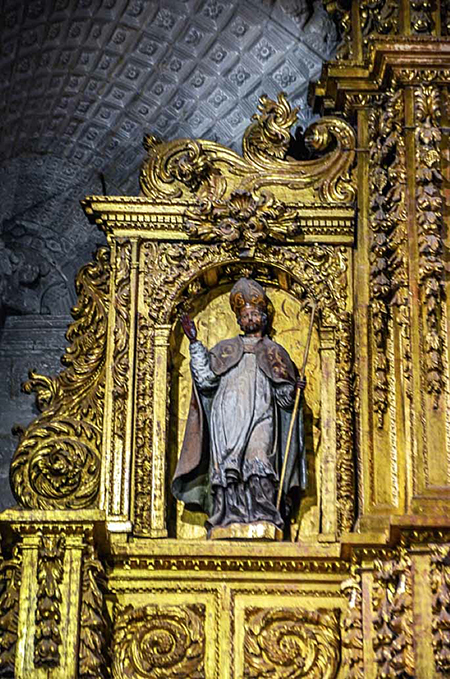
Image of San Fermín from the main altarpiece of Larraga, by Francisco Jiménez Bazcardo, 1697. Photo I. Yoldi
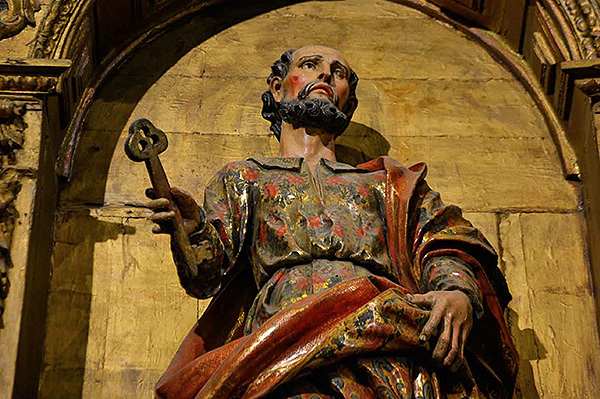
Sculpture of Saint Peter from the main altarpiece of Larraga, by Francisco Jiménez Bazcardo, 1697, polychromed in 1700 and polychromed again in 1748. Photo I. Yoldi
